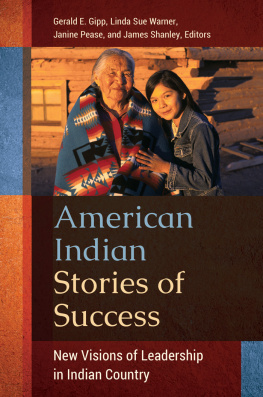AMERICAN INDIAN STORIES OF SUCCESS
New Visions of Leadership in
Indian Country
Gerald E. Gipp, Linda Sue Warner,
Janine Pease, and James Shanley, Editors

Copyright 2015 by Gerald E. Gipp, Linda Sue Warner, Janine Pease, and James Shanley, Editors
All rights reserved. No part of this publication may be reproduced, stored in a retrieval system, or transmitted, in any form or by any means, electronic, mechanical, photocopying, recording, or otherwise, except for the inclusion of brief quotations in a review, without prior permission in writing from the publisher.
Library of Congress Cataloging-in-Publication Data
American Indian stories of success : new visions of leadership in Indian Country / Gerald E. Gipp, Linda Sue Warner, Janine Pease, and James Shanley, editors.
pages cm
Includes bibliographical references and index.
ISBN 9781440831409 (cloth : alk. paper) ISBN 9781440831416 (ebook) 1. Indian educatorsUnited StatesBiography. 2. Indians of North AmericaEducationUnited StatesHistory20th century. 3. Indian universities and collegesUnited StatesAnecdotes. 4. Educational leadershipUnited States. 5. Educational changeUnited States. I. Gipp, Gerald E., editor. II. Warner, Linda Sue, 1948- editor. III. Pease, Janine, editor. IV. Shanley, James, editor.
E97.A4472015
370.922dc23 [B] 2014049729
ISBN: 9781440831409
EISBN: 9781440831416
19 18 17 16 151 2 3 4 5
This book is also available on the World Wide Web as an eBook.
Visit www.abc-clio.com for details.
Praeger
An Imprint of ABC-CLIO, LLC
ABC-CLIO, LLC
130 Cremona Drive, P.O. Box 1911
Santa Barbara, California 93116-1911
This book is printed on acid-free paper 
Manufactured in the United States of America
Contents
| Dave Archambault Sr. |
| Earl J. Barlow |
| Robert Keams Chiago |
| David Beaulieu |
| Rosemary Ackley Christensen |
| Joe McDonald |
| Sandra J. Fox |
| David M. Gipp |
| Perry Horse |
| Cynthia Lindquist |
| Janine Pease |
| Linda Sue Warner |
| Barbara Bartone |
| Don Day |
| John Forkenbrock |
| Gerald E. Gipp |
| Lois Fister Steele |
| Rick St. Germaine |
| John W. Tippeconnic III |
| Ray Barnhardt |
| Roger Bordeaux |
| Cheryl Crazy Bull |
| Denny Sparr Hurtado |
| Thomas Shortbull |
Preface
When Dr. Jim Shanley and I worked together for American Indian Higher Education, we discussed the progress of Indian education and how it occurred over the past several decades. We were cognizant of Indian educators and tribal leaders whose contributions to the effort were commonly acknowledged, but we were also appreciative that there was a cadre of highly successful Indian leaders with stories of success that were yet untold. The idea of capturing these stories and progress throughout Indian country over the past four decades was germinated. It became paramount to capture the stories before they faded into the distant past. Unfortunately, we have already lost too many of our colleagues whose stories will never be fully documented and shared.
Thus, our goal was to create a document focused on lessons learned to be shared with future Indian leaders and researchers, students in tribal colleges and universities, students in leadership training programs, and students and parents in Indian schools across the country. We were fortunate to gain the interest and guidance of Dr. Linda Sue Warner, who provided the required expertise to help make this publication a reality. We also sought out Dr. Janine Pease to join us in this endeavor because of her experiences and expertise in the field. The four of us agreed on a common goal of working together as coeditors to identify and solicit potential contributors and to prepare the submissions for publication.
We are extremely sensitive to the tremendous diversity across the larger world of tribal communities and Indian education and the reality that there are so many other leaders and stories that could be included in this publication. Therefore, it is our greatest hope that this limited beginning will lead to similar future publications to share the evolving story of American Indian education.
Gerald E. Gipp
Introduction
This collection of stories comes from a unique group of survivors: individuals who, out of hundreds of thousands of postWorld War II American Indian people, were able to move through a largely oppressive, discriminating, and disinterested educational system to become education leaders. Although these writers are successful, they are not ambitious people in the common sense of the word. They arose from families and traditions that stress leadership for the survival and well-being of others.
The stories are autobiographical and are set between roughly 1960 and the present. This has been a time of vast social change in the United States for peoples of color. And although these stories play out on a background of civil rights, racism, and discrimination, they point more directly at relationships that American Indians have endured with the U.S. government and consequently state governments. At the same time, Indians struggled with mythical perceptions in society ranging from the vanished Americans through bloodthirsty savages, valiant soldiers, mystical warriors, visionary statesmen, and casino moguls. The writers of these stories would insist that they are common people who, with luck, were called to service.
The stories are written in different styles: scholarly works, biographies, lessons learned, and summations of careers that encompass changing points of view. Some of the writers refer to oral tradition as a reference that forms a tribal worldview and makes up the context of the story. And despite coming from different geographical regions and different tribes with different languages, the similarity of the tribal worldviews is very evident. Many of these people know each other and actually worked with each other during the changing time of the twentieth century. This speaks to the its a small world nature of Indian leaders. The writers seem to speak as a compulsion to add to a long tradition of talking of things that will be valuable to their relatives, their tribes, and other American Indians in the future. These are stories that had to be told.
As in most good stories, the journey itself is as important as the destination. These stories move through time and space in both a historical sense and an educational sense. There is much more emphasis on the positive than the negative. The realization that the journey is far from over is a large, ever-present theme. A future that is changing more rapidly than at any time in human history brings imperatives of survival to tribal people that are now more important than ever. Native American tradition talks of a path of destiny for people. Among the Great Plains tribes, this is referred to as the Red Road. If a person lives with courage, kindness, and generosity, then fate will lead him or her to a life of peace, harmony, and beauty.
This collection also includes stories from three individuals who are not American Indians. These people spent significant portions of their lives working with the other writers and assisted greatly in their aspirations. These stories offer a slightly different perspective for the developments described by the other writers.
Next page












